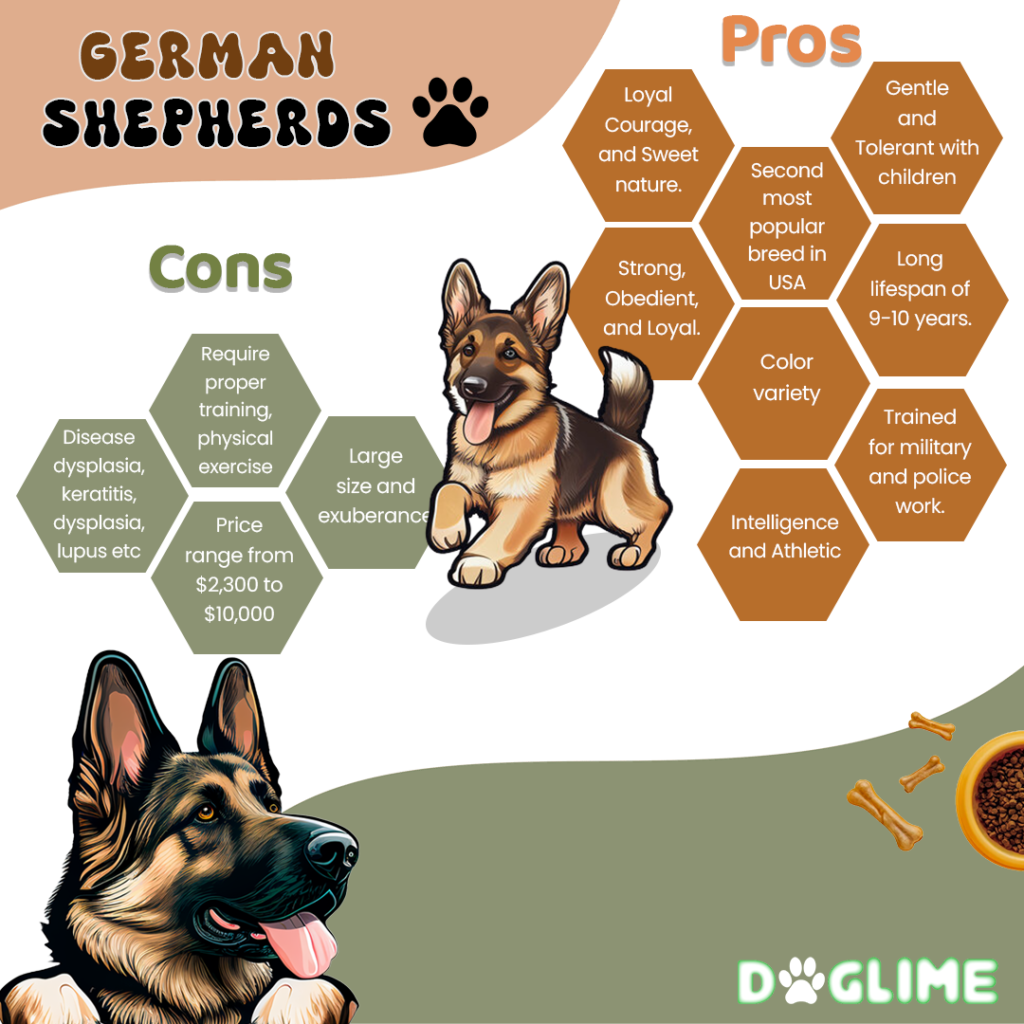German Shepherd Dog Breed Information
General Information
| Dog Name | German Shepherd Dog |
|---|---|
| Other Names | Deutshe Schäferhund |
| Scientific Name | Canis lupus familiaris |
| Breed Type | Shepherd |
| Group | Herding |
| Breed For | Herding Sheep and Cattles |
| Extinct | No |
| Country of Origin | Germany |
Physical And Size
| Size | Large |
|---|---|
| Min Life Span | 7 |
| Max Life Span | 10 |
| Min Ideal Weight for male | 29 |
| Max Ideal Weight for male | 31 |
| Min Ideal Weight for female | 22 |
| Max Ideal Weight for male | 31 |
Ranking
| Intelligent Rank | |
|---|---|
| Trainability | |
| Playfulness | |
| Affection Level | |
| Social Needs | |
| Barking | |
| Watchdog Ability | |
| Territorial | |
| Mouthiness | |
| Adaptability |
Characterisitics
| Temperament | Courageous, Smart, Loyal |
|---|---|
| Prey Drive | Yes |
| Fighting Dog | No |
Friendliness
| Stranger Friendly | Low |
|---|---|
| Child Friendly | High |
| Cat Friendly | Medium |
| Dog Friendly | Low |
| Office Friendly | Low |
| Apartment Friendly | Medium |
| Senior Citizens Friendly | Medium |
| Service Dog | Medium |
| Search and Rescue Dog | Medium |
| Biting Potential | Medium |
| Country of Origin | Germany |
| Nicknames and Other Names | GSD, Deutshe Schäferhund, DSH, Alsatian Wolf Dog, Berger Allemand |
| Scientific Name | Canis lupus familiaris |
| Breed Type | Shepherd |
| Group | Herding |
| Bred For | Herding Sheep and Cattles |
| Size | Large-Sized |
| Recognized By | AKC, UKC, KC (UK), FCI, NZKC, ANKC, CKC |
| Life Span | 7-10 Years |
| Ideal Weight | 65-90 pounds (Male) 50-70 pounds (Female) |
| Ideal Height | 24-26 inches (Male) 22-24 inches (Female) |
| Fur Type | Double Coated |
| Common Colors | Black, Black & Cream, Black & Tan, Black & Silver, Black & Red, White |
| Markings | Blue, Gray, Brown, Liver, Panda |
| Availability | Easily Available |
| Achievements | Ranked in Army |
| Suitable for Apartments | Yes |
| Used in World War | Used as Military Dogs |
| Most Similar To | Belgian Tervuren |
The large guard dog, often known as ‘One man breed’ is none other than a German Shepherd. German Shepherds are famous for having reputations like loyalty, courage, and sweet nature. They are dogs who can work all day long which makes them well-known workaholics.
With their extreme loyalty and sweet nature, they are the second most popular dogs in America after the Labrador Retriever. They are brilliant canines with an aptitude for love, knowledge, and stimulation.
History And Origin Of German Shepherd Dog Breed
German Shepherd originated in Germany back in the early 19th century when a German cavalry captain decided to ‘breed one of the most dexterous herding dogs in the world’. However many would not agree with the description but he succeeded in breeding the most well-rounded dogs.

Traveling through various regions for the perfect dog to combine, Von Stephanitz, started attending different dog shows. Finally, a wolf-like dog caught his eye and adopted it to create a perfect descendant. Which he surely did!

As Germany was moving towards industrialization, Von found it more reasonable that his breed could perform military and police services too. Being part of the military, he succeeded in convincing the German government to use the dog in various tasks. Shortly after, the dogs were used as rescuers, carriers, guards, and messengers during World War I.
The German Shepherds were immediately prized for their astounding intelligence, athleticism,
Shortly after, the breed became famous in the US. Their intelligence and fearlessness helped a lot of US soldiers to bring back home. They started serving as, military dogs, guard dogs, police dogs, therapy dogs, service dogs, and many more. When it comes to trainability, they have a stance of their own.
Are Your Child Safe With GSDs?
YES! Your child is absolutely safe with the German Shepherds. They are very gentle with the kids which makes them the best-play mate. Your pet will tolerate pokes, grabs, and occasional tail-pulling too.
Your children are full of energy and so do German Shepherds. This endless energy paired with high intelligence will be a plus point for your kids, as they can teach your pet new games and tricks which they learn very quickly.
As German Shepherds are large, they stand up to a height of 26 inches and weigh up to 90 pounds. This might be a threat to a toddler bouncing around. These gentle giants won’t hurt the children intentionally but may harm them accidentally if overly exuberant.
Shepherds could get a little mouthy while teething or playing. So, it is important to avoid it by providing chew toys and putting
Behavior, Temperament, and Personality

The German Shepherd dogs are best known for their strong, obedient, and loyal nature. They are guard dogs and protectors. However, first and foremost they are herding dogs and make a wonderful family companion.
Their personality is marked as fearless, self-confident, and develop indiscriminate friendships. They seem aloof towards strangers however once they get friendly it will remain till life long.

GSD’s
As they were trained as fighters, they will need proper training and socialization in their youth to be good family pets. They have the ‘alpha’ kind of personality which means, they will rule your or your family if they sense the lack of leadership.
Trainability
German Shepherds are large, energetic, and require physical as well as mental exercise. They thrive in their training sessions and love playing fetch with a stick, ball, and frisbee. While highly trainable they need to be socialized with different people and animals.

Some say German Shepherds shouldn’t
Facts You Need To Know About The “One-Man Breed”
- The German Shepherds are the second most popular dogs in the US after Labrador Retriever.
- They are naturally curious, which makes them thrive in search missions.
- German Shepherds are highly intelligent and it takes only 5 repetitions to learn a new thing.
- They are found in a variety of colors like blue, liver, all black, and all white. In which the most common colors are tan, black, and red.
Common Health Issues Found In German Shepherd
| General Health | Healthy |
| Common Health Issues | Bloat, Cherry Eye, Chronic Diarrhea, Blindness, Allergies, Hip Dysplasia, Elbow Dysplasia, Epilepsy, Pannus, Paralysis, Lupus |
| Hypoallergenic | No |
| Vaccination Required | Leptospirosis, Canine Parainfluenza, Rabies, Canine Distemper, Canine Parvovirus, Kennel Cough, Canine Coronavirus |
| Shedding | Heavy Shedder |
| Drooling | Low |
| Grooming | Average Grooming Required |
| Weight Gain Potential | Low to Average |
| Separation Anxiety | Moderate Chance |
| Allergies | Skin Allergy |
| Diets and Supplements | Crude Protein: 32% Crude Fat: 18% Crude Fiber: 4% Glucosamine Probiotics Lysine Digestive Enzymes |
The German Shepherd is undoubtedly a healthy dog living up to 9-10 years. However, it is important you get all the health information of the breed and their parents. The common health problems found in German Shepherds are given below.
- Hip Dysplasia: If you’re not acquainted well with the dogs then you might not know that the German Shepherds can have bad hips. That means hip dysplasia is a common problem in Shepherds. Only 20% of the shepherds are affected by this issue. Hip dysplasia means displacement of the joints. Its symptoms are an abnormal gait, pain while walking, and lameness in the legs. You should consult the vet as soon as possible before it gets serious.
- Keratitis: This condition occurs when the cornea inflames. Cornea means the dome covering the eye’s pupil and iris. This condition can affect your dog’s vision and are also very painful which makes it hard to open their eyes. This eye condition is caused by bacteria, fungi, and sometimes even bad genes.
- Elbow Dysplasia: This occurs due to the displacement of the elbow. It can cause them difficulty in straightening their joints. It occurs due to the lack of proper exercise.
- Lupus: Lupus affects the skin of the shepherds making them red, crusty, itchy, and abnormal-looking. The latter spreads throughout the body causing organ failure, muscle atrophy,
and decreased appetite. Quick medications and diet can save your dog from Lupus.
These were some common health issues found in German Shepherds. As we all know, prevention is better than cure. As soon as you find something inappropriate in your pet, immediately consult your vet before it’s too late.
Most Common German Shepherd Color Patterns
- Black
- Black and Red
- Black with cream color heels
- Blue
- Liver and Tan
- White
- Sable or Grey
German Shepherd Puppies
The price of the German Shepherd puppy depends on how they are bred. It costs up to $2,300 to $10,000 for the top breeds.
Which Dogs Are They Similar To?
Visit Doglime for more Dog Breed Information.
Tags











5 thoughts on “German Shepherd Dog Breed Information”